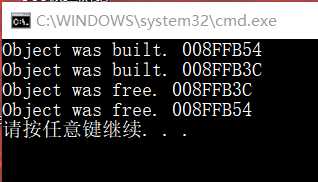赋值函数(运算符重载)
Posted area-h-p
tags:
篇首语:本文由小常识网(cha138.com)小编为大家整理,主要介绍了赋值函数(运算符重载)相关的知识,希望对你有一定的参考价值。
&1.参数使用引用是为了增加效率,因为如果不是引用,参数为对象则会调用拷贝构造函数
2.函数具有返回值是为了,若有连等赋值,保证其正常赋值
3.判断语句是为了保证不会出现自己给自己赋值的情况
4.返回值为引用是为了提升效率
赋值函数表面看起来只是对象赋值给对象,实际上是=号前的对象调用operator=方法,赋值函数的参数即为
=号后的对象
void main()
{
ST t(10,20);
ST t1;
t1 = t; //这里原理应该是 t1.operator=(&t)
}
//Test1.h #include<iostream> using namespace std; class ST { private: int a; double b; public: ST(int a=0,double b=0):a(a),b(b) { this->a = a; this->b = b; cout<<"Object was built. "<<this<<endl; } ST(const ST &t);//拷贝构造 ST& operator=(const ST &t); ~ST() { cout<<"Object was free. "<<this<<endl; } }; ST::ST(const ST &t) { this->a = t.a; this->b = t.b; cout<<"Object was copy. "<<this<<endl; } //在类外实现方法时: 返回值 类名 ::函数名(参数) ST& ST::operator=(const ST &t) { if(this != &t) { this->a = t.a; this->b = t.b; } return *this; }
#include<iostream>
#include"Test1.h"
using namespace std;
void main()
{
ST t(10,20);
ST t1;
t1 = t;
}
运行结果

以上是关于赋值函数(运算符重载)的主要内容,如果未能解决你的问题,请参考以下文章